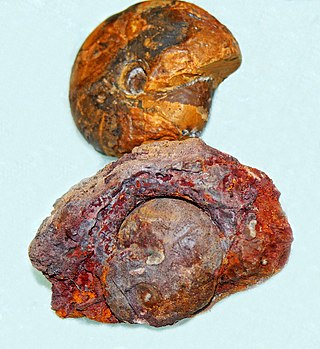
Goniatites is a genus of extinct cephalopods belonging to the family Goniatitidae, included in the superfamily Goniatitaceae. Hibernicoceras and Hypergoniatites are among related genera.
Acrimeroceras is an oxyconic Devonian goniatite and one of three genera included in the subfamily Paratornoceratinae. The others being Paratornoceras and Paratoceras or exPolonites.
Agathiceras is a subglobose goniatitid from the family Agathiceratidae, widespread and locally abundant in Lower Pennsylvanian to Middle Permian sediments, e.g. the Urals, Sicily, and Texas.

Beyrichoceras is a genus belonging to the goniatitid family Maxigoniatitidae that lived during the Mississippian Period
Prolobitidae is a family of middle and upper Devonian ammonoid cephalopods currently included in the goniatitid suborder Tornoceratina and superfamily Dimeroceratoidea, but previously included in the ancestral Anarcestida.
Cheiloceratidae is a family of ammonoid cephalopods included in the goniatitid suborder Tornoceratina in which the suture has 4 to 12 lobes, the ventral one undivided and those in the lateral areas originating as subdivisions of internal and external lateral saddles.
Tornoceratoidea, also known as Tornocerataceae, is a superfamily of goniatitid ammonoids included in the suborder Tornoceratina. Tornoceratoidea, or Tornocerataceae, is essentially the Cheilocerataceae of Miller, Furnish, and Schindewolf (1957) in the Treatise Part L, revised to accommodate new taxa and new perspectives on the phylogeny.
Tornoceratidae is a family of goniatitid ammonoids from the middle and upper Devonian. The family is included in the suborder Tornoceratina and the superfamily Tornoceratoidea.
Adrianitidae is a family in the Adrianitaceae, a superfamily of ammonites in the cephalopod order, Goniatitida, known from the Middle Pennsylvanian to the Middle Permian.
Texoceras is an extinct ammonoid genus in the monotypic goniatitid subfamily Texoceratinae, included in the family Adrianitidae. These are shelled cephalopods more closely related to squids, belemnites, octopuses, and cuttlefish than to nautiloids from which they are derived.

Goniatitidae is one of three families included in the ammonoid cephalopod superfamily Goniatitoidea, known from the Lower Mississippian to the Upper Permian. They have sutures that form 8 lobes and characteristically lack sculpture. The ventral lobe, as for the superfamily, is bifurcated.
The Ammonellipsitinae is a subfamily within the Pericyclidae, a family within the goniatitid superfamily Pericycloidea from the Lower Carboniferous (Mississippian) characterized by having a suture in which the sides of the ventral lobe diverge and the first lateral saddle is acute or subacute, and in which the immature and juvenile shell has a wide umbilicus.

Medlicottiidae is a family of ammonoid cephalopods belonging to the Prolecanitida, known from the Upper Carboniferous (Pennsylvanian) to the Early Triassic.

Prolecanitida is an order of extinct ammonoid cephalopods, the major Late Paleozoic group of ammonoids alongside the order Goniatitida. Prolecanitids had narrow shells, discoidal (disc-shaped) to thinly lenticular (lens-shaped). They retained a retrochoanitic siphuncle, a simple form with septal necks extending backwards. As is typical for ammonoids, the siphuncle sits along the ventral margin of the shell.

Clyclolobus is a smooth, essentially involute subdiscoidal goniatitid ammonoid that has sutures with a bifurcate ventral lobe, flared outwardly at the end, in which the halves may be secondarily trifurcated, ending in sharp, narrow projections. Lateral sutural elements follow an acuate line that swings first to the front, then sharply to the rear before becoming hidden by the next whorl. Saddles are narrow, cumulous in appearance with short, irregular, rounded sub-endings. Ventro-lateal lobes are trifurcate with pointed, thorn-like projections.
Pachylyroceras is a large, generally subglobular, Upper Mississippian gonitite and included in the cephalopod subclass Ammonoidea.
Lyrogoniatitites is a neoglyphioceratoidean ammonite, in the order Goniatitida, related to genera like Alaoceras, Cravenoceras, Dumbarigloria and Pachylyroceras.
Cravevoceras is an Upper Paleozoic ammonite in the goniatite family Cravenoceratidae, probably derived from Pachylyroceras and contemporary with other cravenoceratid genera like Caenolyroceras, Tympanoceras and later Alaoceras and Lyrogoniatites. It is also a member of the Neoglyphioceratoidea.
The Uddenitinae a subfamily of the Medlicottiidae, a family of ammonoid cephalopods included in the Prolecanitida. The Uddenitinae, proposed by Miller and Furnish, and known from the Pennsylvanian and Lower Permian, are transitional between the ancestral Pronoritidae and the more traditional medlicottiids

The Medlicottiinae is a subfamily of the Medlicottiidae, a family of ammonoid cephalopods included in the Prolecanitida, characterized by having discoidal to thinly lenticular shells with a retuse (grooved) venter and sutures with bifid auxiliary lobes.






